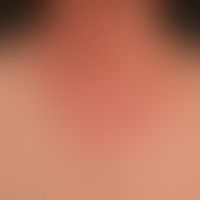Image diagnoses for "Torso", "Plaque (raised surface > 1cm)", "red"
205 results with 655 images
Results forTorsoPlaque (raised surface > 1cm)red

Larva migrans B76.9
larva migrans. chronic dynamic disease, which appeared 3 weeks ago after a holiday in kenya. multiple, irregularly distributed, sharply defined, linear, strongly itching, firm, red, smooth papules, localized on the buttocks. in the marker test the anterior end of the duct grows 1-2 cm daily.

Lichen simplex chronicus L28.0
Lichen simplex chronicus. detail enlargement: Strongly itchy, 0.1-0.2 cm large, solid, sharply defined, flat, skin-coloured to reddish papules and plaques as well as scratch excoriations.

Lichen simplex chronicus L28.0
Lichen simplex chronicus: chronic plaque consisting of peripherally disseminated, solid, red papules confluent in the centre of the lesion; intermittent itching leading to unsuppressible scratching

Netherton syndrome Q80.9
Netherton syndrome: clinical picture already manifested in childhood with the formation of large, also circulatory, garland-like, brown-red or red surface-rough, scaly plaques; numerous type I sensitizations.

Linear porokeratosis Q82.8
Porokeratosis linearis unilateralis: Multiple, chronically stationary, first appeared 2 years ago, since then persisting, on the lower abdomen half-sided localized, striped, 0.2-4.0 cm large, partly isolated, partly confluent to larger areas, brown, rough papules and plaques.

Atopic dermatitis (overview) L20.-
Generalized atopic eczema: Exacerbated, generalized seizure-like itchy dermatitis with multiple, chronically dynamic, symmetrical, blurred, red, rough, flat plaques as well as flat, dry scaling red spots in a 19-year-old female patient.

Erysipelas A46
Erysipelas, acute: under high fever, , within 2 days appeared, sharply limited flat, saturated redness and plaque formation of the left buttock. accompanying: painful regional lymphadenitis.

Airborne contact dermatitis L23.8
Airborne Contact Dermatitis: Subacute, blurred, red plaque, here the transition to the non-free skin areas.

Psoriasis vulgaris chronic active plaque type L40.0
Psoriasis vulgaris chronic active plaque type: relapsing-active plaque psoriasis.

Photoallergic dermatitis L56.1
eczema, photoallergic. 51-year-old female patient. generalized skin disease with 0.2-0.4 cm large, red, slightly scaly papules (see lower margin of the picture), which have merged into flat plaques on the exposed skin areas. sudden spread. appearance within a few weeks after infection, intake of antibiotics as well as later exposure to sunlight.

Dress T88.7
DRESS: 4 weeks after taking carbemazepine, appearance of this generalized maculo-papular exanthema. onset in the face with spreading to the whole body. marked itching.

Toxic epidermal necrolysis L51.2
Toxic epidermal necrolysis: incipient extensive necrolytic detachment of the skin.

Pityriasis rubra pilaris (adult type) L44.0

Candidoses B37.9
Candidoses: Female, 62 J. Candida submammary under long-term steroid-containing local therapy of an inverse psoriasis; note the marginal satellite nodules.

Nummular dermatitis L30.0
Nummular Dermatitis: Multiple, reddened, confluent, roundish or bizarrely configured plaques with weeping yellowish crusts on the back of a 76-year-old female patient.

Parapsoriasis en plaques benign small foci L41.3
parapsoriasis en plaques, benign small hereditary form. 55-year-old patient with small spotted parapsoriasis en plaques (also called chronic superficial dermatitis). the distribution pattern (fingerprint dermatosis) in the longitudinal direction of the skin tension lines is almost diagnostic. occasionally slight itching (mostly in the winter months). in summer (after sea vacation) almost healed. histology is often not conclusive.

Skabies B86
Scabies:explanatory presentation; chronic (existing for months) generalized, "eczematous", enormously itchy disease pattern with rough papules in the shape of a duct (here marked by black lines), encircling a chronically eczematized skin area without detectable duct structures.)

Pityriasis rosea L42
Pityriasis rosea. truncated, díchtes maculopapular exanthema arranged in the cleft lines, little itching.

Tinea corporis B35.4
Tinea corporis: peripheral, peripherally progressive, moderately itchy, concentric focus with fine and coarse lamellar scaling on the trunk.





